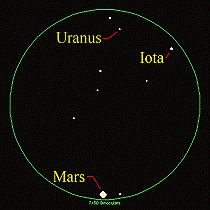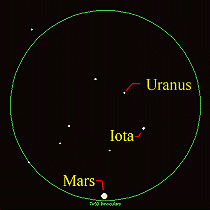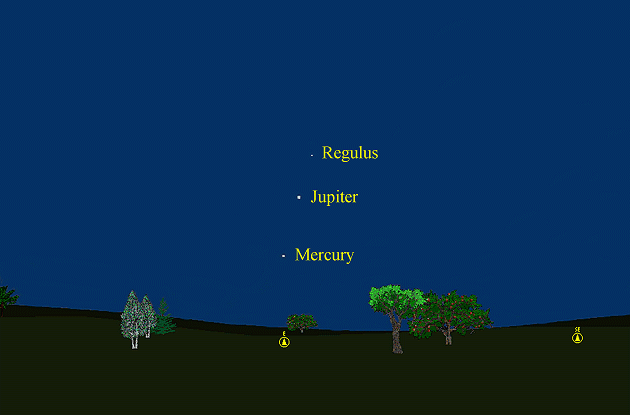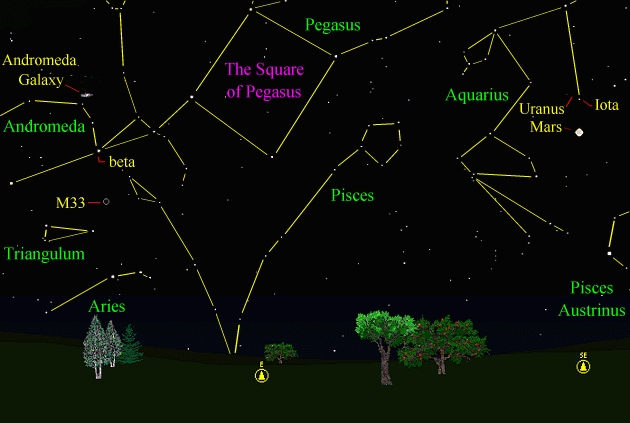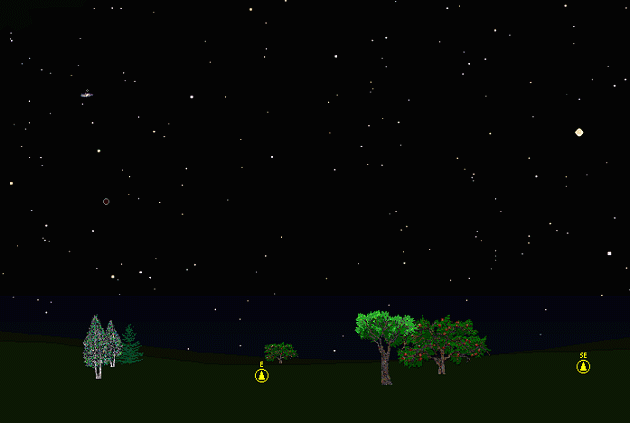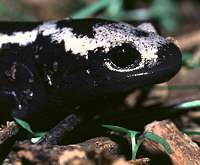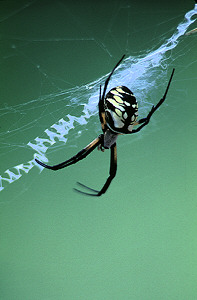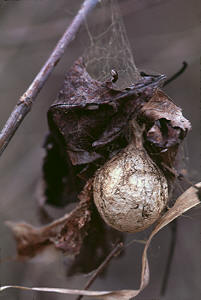|
The purpose of this feature is to give scout
leaders, educators and naturalists an idea of some of the natural events coming
up each month. We will try to cover a variety of natural events ranging
from sky events to calling periods of amphibians, bird and mammal watching
tips, prominent wildflowers and anything else that comes to mind. We
will also note prominent constellations appearing over the eastern horizon at
mid-evening each month for our area for those who would like to learn the
constellations. If you have suggestions for other types of natural
information you would like to see added to this calendar, let us know! Note: You can click on the hyperlinks to learn more about some of the featured items. To return to the Calendar, hit the "back" button on your browser, NOT the "back" button on the web page. Sky Events: Evening Sky: Bright Mars dominates the evening and morning sky again this month. At midmonth it rises before sundown, but for good telescopic views you need to look at it when it is due south and highest in the sky, around 11:30 pm CDT at midmonth. Otherwise, the atmospheric turbulence near the horizon will blur your views considerably. You can watch the south polar cap continue to shrink as summer begins in the southern hemisphere of Mars on September 29th. The distant gas giant Uranus is less than 6 and 1/2 degrees from Mars the whole month of September, and this is a great chance to spot the planet in binoculars and watch it move slowly relative to the stars around it. Just place Mars in the bottom of your binocular field and then look above it as shown in the constellation charts below and on the binocular finder charts. In binoculars Uranus looks like a faint star, so to verify you've actually seen it you must plot the positions of the other stars, like iota Aquarii, in the binocular field (iota is the brightest) and then look again after a couple of weeks have gone by. Positions, and the field of view of 7x50 binoculars, are shown for September 5, 15, and 30th, all at 9:00pm CST. If you make your search later than 9:00pm CDT the field of view will rotate clockwise. Telescopic views require about 150 power to see the tiny pale greenish disk of the planet. Can you figure out why Mars and Uranus are moving in different directions?
Although Venus has moved into the evening sky this month, it is still too close to the sun to be seen easily. Morning Sky: Saturn rises about 12:45 am CST at midmonth. Jupiter rises about 5:00am at midmonth. Mercury and Jupiter and the star Regulus make for a pretty grouping on the morning of September 27th. Shown is the view looking east at 6:10am.
All times noted in the Sky Events are for Franklin, Tennessee and are Central Daylight Time. These times should be pretty close anywhere in the mid-state area. Constellations: The views below show the sky looking east at 9:00pm CDT on September 15th. The first view shows the sky with the constellation outlined and names depicted. Star and planet names are in yellow. Constellation names are in green. The second view shows the same scene without labels. Pegasus, the Flying Horse, appears higher above the eastern horizon this month, as does Andromeda, Princess Andromeda. Look above beta Andromedae and see if you can pick out the faint glow of the Andromeda Galaxy, over 2 million light years away! City dwellers may need binoculars to pick it out. Simon Marius, in 1610, compared it's soft glow to "the light of a candle shining through horn." To get the best view, wait till the square is high overhead to look. If you find the Andromeda Galaxy, you might want to try and see if you can see M33, another nearby galaxy in Triangulum, the Triangle. Find the "Square of Pegasus" and work your way outward from it to the constellations around it.
On Learning the Constellations: We advise learning a few constellations each month, and then following them through the seasons. Once you associate a particular constellation coming over the eastern horizon at a certain time of year, you may start thinking about it like an old friend, looking forward to its arrival each season. The stars in the evening scene above, for instance, will always be in the same place relative to the horizon at the same time and date each September. Of course, the planets do move slowly through the constellations, but with practice you will learn to identify them from their appearance. In particular, learn the brightest stars for they will guide you to the fainter stars. Once you can locate the more prominent constellations, you can "branch out" to other constellations around them. It may take you a little while to get a sense of scale, to translate what you see on the computer screen or what you see on the page of a book to what you see in the sky. Look for patterns, like the stars that make up the "Square of Pegasus." The earth's rotation causes the constellations to
appear to move across the sky just as the sun and the moon appear to do.
If you go outside earlier than the time shown on the charts, the constellations
will be lower to the eastern horizon. If you observe later, they will
have climbed higher. As each season progresses, the earth's motion around the sun
causes the constellations to appear a little farther towards the west each
night for any given time of night. If you want to see where the
constellations in the above figures will be on October 15th at 9:00pm CDT, you
can stay up till 11:00pm CDT on September 15th and get a preview. The westward
motion of the constellations is equivalent to two hours per month. A good book to learn the constellations is H. A. Rey's
classic, The Stars, A New Way to See Them. Rey's depictions of the
constellations and witty commentary are terrific. A good general reference book on astronomy is the Peterson
Field Guide, A Field Guide to the Stars and Planets, by Pasachoff.
The book retails for around $14.00. A good beginners software program for learning the night sky
is the Starry Night Beginner program. Visit the Starry Night web site at
www.starrynight.com The program retails for around $30.00 and
contains a wealth of information. Amphibians:
The frog and toad choruses start waning in September but some frogs and toads are still calling. Another name for the Spring Peeper is the "Autumn Piper", and these small frogs can be heard calling from patches of woods in the fall. On cooler September nights, Southern Leopard Frogs sometimes call and breed as the cooler temperatures mirror their early spring breeding period. You can locate many of the frogs and toads that have been calling more frequently earlier in the year by driving the back roads slowly on rainy nights.
This is a two person job. One person watches the road for amphibians and one person looks out for other vehicles. Anything over about 15mph is "speeding". On wet nights in September, look for breeding Marbled Salamanders in flooded woodland areas. We found one such area where we had previously heard a breeding chorus of Upland Chorus Frogs.
Birds: Fall migration reaches its peak as September progresses. Be sure to check around ponds, river banks and on exposed mud flats for shorebirds, as many pass through Tennessee in the fall. Hawks peak around the third week in September, and you might want to consider a hawk-watching trip. For good locations, see Bird Finding in Tennessee, below. A trip to the banks of the Mississippi River this time of year can yield numerous shorebirds and large flocks of White Pelicans migrating overhead (we saw 58 birds in one flock in the fall of 2001), and Least Terns flying up and down along the river. Recommended: Bird Finding in Tennessee, Michael Lee Bierly. A classic guide to finding birds in Tennessee. The Sibley Guide to Birds, David Allen Sibley For the eastern United States only, A Field Guide to the Birds East of the Rockies, Roger Tory Peterson An inexpensive guide for beginners is the Golden Guide for Birds.
Spiders:
Late summer is a great time to observe spiders. One commonly seen spider this time of year is the beautiful Black-and- Yellow Argiope. The body length on the female Argiopes can range up to 1-1/8 inches long. You can sometimes spot the much smaller male Argiope (body length only about 3/8" long) at the edges of the female's web. Black-and-Yellow Argiopes are quite beneficial and feed on a wide variety of flying insects such as aphids, flies, grasshoppers, wasps and bees. Although these spiders may bite when harassed, their venom apparently does not cause problems for humans. Their webs have a characteristic zigzag pattern in the center (see the photo) called the "stabilimenta", so named because it was first thought to provide structural stability for the web.
One competing hypothesis is that the highly visible threads prevent birds from flying through the webs. After mating, the female Black-and-Yellow Argiope produces one or more papery egg sacs. These sacs (Charlotte's "magnum opus" in the book Charlotte's Web, although Charlotte was a Barn Spider) are round and up to an inch in diameter. Each sac contains from 300 to 1400 eggs. The male dies soon after mating, but the females survive until the first hard frost. The young spiderlings hatch in the fall, but overwinter in the sac and do not emerge until the spring. It's interesting to think about them riding out the winter storms in their protective home.
Archives (Remember to use the back button on your browser, NOT the
back button on the web page!)
Natural Calendar
February 2003
Natural Calendar
December 2002
Natural Calendar
November 2002
Nature Notes Archives:
Nature Notes was a page we published in 2001 and 2002 containing our
observations about everything from the northern lights display of November 2001
to frog and salamander egg masses. Night scenes prepared with Starry Night Pro software All photographs
Ó2003
LEAPS
|
|||||||||||||||||||||||||||
